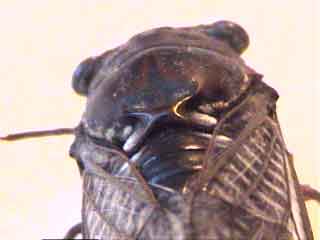Lv:11:22: Even these of them ye may eat; the locust after his kind, and the bald locust after his kind, and the beetle after his kind, and the grasshopper after his kind.

Mt:3:4: And the same John had his raiment of camelʼs hair, and a leathern girdle about his loins; and his meat was locusts and wild honey. (KJV)
Calvin W. Schwabeʼs Unmentionable Cuisine (University Press of Virginia, 1979).
Locusts and grasshoppers are prepared for cooking by removing the wings, the small legs, and the distal portion of the hind legs. Then pull off the head, withdrawing any attached viscera. Boil prepared Rocky Mountain locusts in salted water. Add assorted cut-up vegetables, butter, salt, and vinegar to the broth and cook until the vegetables are tender. Serve as a thick soup or over boiled rice as a main dish.
A New Voyage Round the World: They had another Dish made of a sort of Locusts, whose Bodies were about an Inch and an half long, and as thick as the top of oneʼs little Finger; with large thin Wings, and long and small Legs. ... The Natives would go out with small Nets, and take a Quart at one sweep. When they had enough, they would carry them home, and parch them over the Fire in an earthen Pan; and then their Wings and Legs would fall off, and their Heads and Backs would turn red like boilʼd Shrimps, being before brownish. Their Bodies being full, would eat very moist, their Heads would crackle in oneʼs Teeth. I did once eat of this Dish, and liked it well enough....
That part about the crispy heads sounds particularly appetizing, doesnʼt it?
More great buggy recipes Dr. Frogʼs Recipe Page
Locusts, from insect family Acrididae, are part of a large group of insects commonly known as grasshoppers. Environmental factors can trigger a behavior change in which the insects no longer act as individuals but as gregarious social pests.
Over the years locust-prone communities have developed recipes to turn the tables on their voracious invaders. “You find large quantities of them for sale in local markets,” said Keith Cressman, FAOʼs locust information officer. “They are very nutritious, because they are high in protein.”
Tinjiya (Tswana recipe): Remove the wings and hind legs of the locusts and boil in a little water until soft. Add salt, if desired, and a little fat and fry until brown. Serve with cooked, dried mealies (corn).
Sikonyane (Swazi recipe): Prepare embers and roast the whole locust on the embers. Remove head, wings, and legs. Only the breast part is eaten.
Source: More recipes at National Geographic
The arrival of locusts was also celebrated in Saudi Arabia. Though the practice of eating them has largely died out, many Saudis recall what it was like. Sometimes the locusts were boiled in salty water, or lightly roasted over coals. Sometimes they were spread out to dry, “lined up like clothespins” on the hot steel of the crude-oil pipelines of the Eastern Province. Anne-Marie Weiss-Armush includes a baked-locust recipe from Yemen in her 1984 cookbook Arabian Cuisine - under ‘Appetizers’. In the morning, she suggests, take two kilos (about 4.5 pounds) of locusts, rinse them, and bake them on a tray at 125 degrees Celsius (250°F) for four hours. Then let them dry in bright sunlight the rest of the day, turning occasionally. Snap off the legs, head and wings before serving.
Saudi Locust Recipes
By popular demand, here are some frog-approved bug recipes!
Hereʼs another locust recipe, this one developed by American pioneers…
http://www.wcu.edu/ubms/frog/frog1.htm
Jewlicious >> Cold Weather Ends Israeli Locust Plague Sikonyane (Swazi recipe): prepare embers and roast the whole locust on the embers… How about a Japanese locust recipe (aka “inago no tsukudani”)?…
http://www.jewlicious.com/?p=467
Find more great locust recipes on Google.


Shellfish, bad. Land-dwelling shellfish-like insects, good.
ReplyDelete